
Young County is a county located in the U.S. state of Texas. As of the 2020 census, its population was 17,867. Its county seat is Graham. The county was created in 1856 and organized in 1874. It is named for William Cocke Young, an early Texas settler and soldier.

Mills County is a county located in Central Texas. It was created on March 15, 1887, from parts of four existing counties—Brown, Comanche, Hamilton, and Lampasas. The 2020 census reported a population of 4,456. The county seat is Goldthwaite.
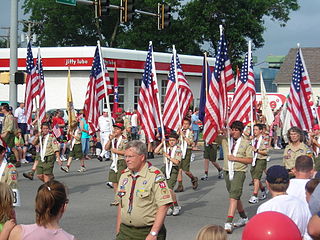
Scouting in Oklahoma has a long history, from the 1910s to the present day, serving thousands of youth in programs that suit the environment in which they live.

Hartshorne is a city in Pittsburg County, Oklahoma, United States. It is the second largest city in the county. The population was 2,125 at the 2010 census.

McAlester is the county seat of Pittsburg County, Oklahoma. The population was 18,363 at the time of the 2010 census, a 3.4 percent increase from 17,783 at the 2000 census. The town gets its name from James Jackson McAlester, an early white settler and businessman who later became lieutenant governor of Oklahoma. Known as "J. J.", McAlester married Rebecca Burney, the daughter of a full-blood Chickasaw family, which made him a citizen of the Chickasaw Nation.

Prosper is a town in Collin and Denton counties in the U.S. state of Texas. Prosper is located within the Dallas-Fort Worth-Arlington metropolitan area. As of the 2010 census, its population was 9,423; As of 2023, the population was 37,746.

Joshua is a city in Johnson County, Texas, United States. The population was 7,891 at the 2020 census.

Cynthia Ann Parker, Naduah, Narua, or Preloch, was a woman who was captured by a Comanche band during the Fort Parker massacre in 1836, where several of her relatives were killed. She was taken with her younger brother, John Richard Parker, and cousin, James Pratt Plummer. Parker was later adopted into the tribe and had three children with a chief. Twenty-four years later she was relocated and taken captive by Texas Rangers, at approximately age 33, and unwillingly forced to separate from her sons and conform to European-American society. Her Comanche name means "was found" or "someone found" in English.
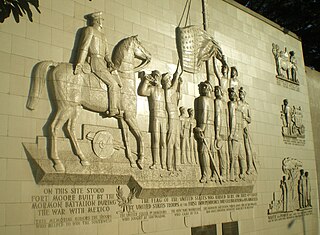
The Mormon Battalion was the only religious unit in United States military history in federal service, recruited solely from one religious body and having a religious title as the unit designation. The volunteers served from July 1846 to July 1847 during the Mexican–American War of 1846–1848. The battalion was a volunteer unit of between 534 and 559 Latter-day Saint men, led by Mormon company officers commanded by regular U.S. Army officers. During its service, the battalion made a grueling march of nearly 2,100 miles from Council Bluffs, Iowa, to San Diego, California.
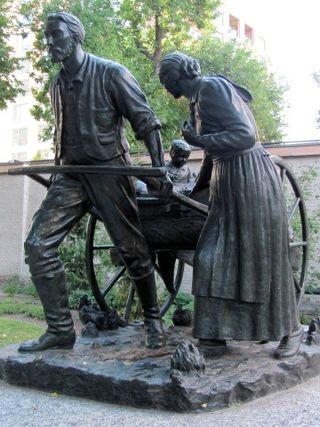
The Mormon pioneers were members of the Church of Jesus Christ of Latter-day Saints, also known as Latter Day Saints, who migrated beginning in the mid-1840s until the late-1860s across the United States from the Midwest to the Salt Lake Valley in what is today the U.S. state of Utah. At the time of the planning of the exodus in 1846, the territory was part of the Republic of Mexico, with which the U.S. soon went to war over a border dispute left unresolved after the annexation of Texas. The Salt Lake Valley became American territory as a result of this war.
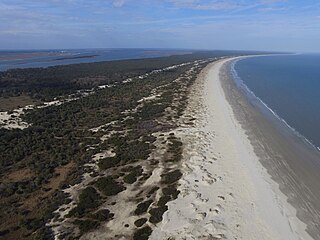
Cumberland Island National Seashore preserves most of Cumberland Island in Camden County, Georgia, the largest of Georgia's Golden Isles. The seashore features beaches and dunes, marshes, and freshwater lakes. The national seashore also preserves and interprets many historic sites and structures.

The Cherokee Trail was a historic overland trail through the present-day U.S. states of Oklahoma, Kansas, Colorado, and Wyoming that was used from the late 1840s up through the early 1890s. The route was established in 1849 by a wagon train headed to the gold fields in California. Among the members of the expedition were a group of Cherokee. When the train formed in Indian Territory, Lewis Evans of Evansville, Arkansas, was elected Captain. Thus, this expedition is sometimes written as the Evans/Cherokee Train. In 1850 four wagon trains turned west on the Laramie Plains, along Wyoming's southern border to Fort Bridger.
Mount Currie is in the Squamish-Lillooet region of southwestern British Columbia. On BC Highway 99, the locality is by road about 160 kilometres (99 mi) north of Vancouver, 39 kilometres (24 mi) northeast of Whistler, and 92 kilometres (57 mi) southwest of Lillooet.
Bluegrove is an unincorporated community on Farm to Market Road 172, 11 miles southeast of Henrietta in central Clay County, Texas, United States.
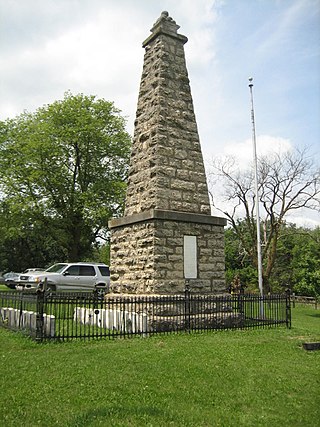
Kellogg's Grove is an area in western Stephenson County, Illinois, United States near the present-day unincorporated town of Kent. The grove is considered historically significant because it was the site of two minor skirmishes during the Black Hawk War in 1832. Today, most of the grove is privately owned but 1.5 acres (6,100 m2) are allocated as a park owned by Stephenson County. While most of the battle occurred on what is today private property the park contains a monument dedicated to the battle and cemetery with the graves of several militia members killed during the skirmish at Kellogg's Grove. The cemetery also holds the graves of those killed in other area battles. The Kellogg's Grove battle site was added to the U.S. National Register of Historic Places in 1978.
Tarkington Prairie is a primarily rural unincorporated community spread out over approximately 238 square miles (620 km2) in northeastern Liberty County, Texas, United States. The community's fire protection is provided by Tarkington Volunteer Fire Department, emergency medical services by Liberty County EMS, and law enforcement by Liberty County Sheriff's Office.

Kirtley is an unincorporated community in west central Fayette County, Texas, United States. It was once known as Primm.
Isidore Robot was a French-born missionary of the Roman Catholic Church who served as Apostolic Prefect of the Indian Territory, Oklahoma from 1876 to 1887.

Travis County has had two locations named Montopolis. The first was during the Republic of Texas period north of the Colorado River. The second is today's Montopolis neighborhood in Austin, Texas south of the river. Located southeast of the city's urban core, today's neighborhood is in ZIP code 78741. Montopolis is bounded by Lake Lady Bird on the north, by Grove Street and the Pleasant Valley neighborhood on the west, to the south by Texas State Highway 71, and by U.S. Route 183 on the east. The southeast corner abuts Austin-Bergstrom International Airport. Montopolis is in City Council District 3.
Bettina is a vanished community founded in 1847 by German immigrants as part of the Adelsverein colonization of the Fisher–Miller Land Grant in the U.S. state of Texas. It was located on the banks of the Llano River in Llano County, and no trace of the settlement remains today. The community was named after German artist and social activist Bettina von Arnim and was one of five attempted by the Darmstadt Forty. It was also known as the Darmstaedter Kolonie. The community was sponsored by the Adelsverein, and founded on idealistic philosophies of European freethinkers of the day. It is notable for the community's camaraderie and mutually respectful relations with local indigenous tribes. Lack of a formal community framework caused Bettina to fail within a year of its founding.


















